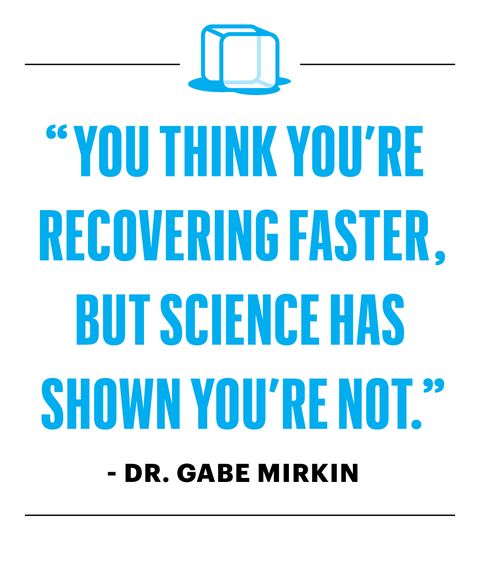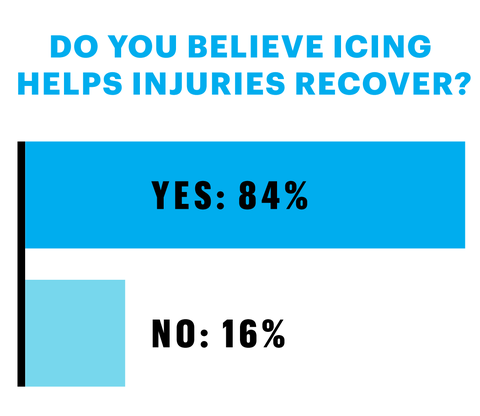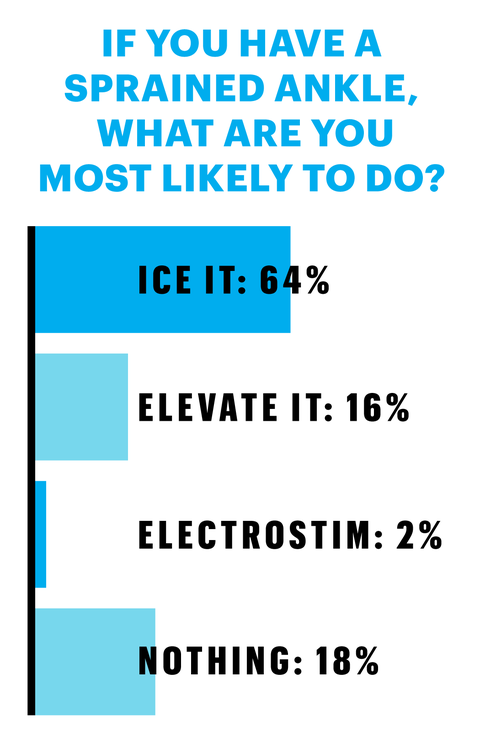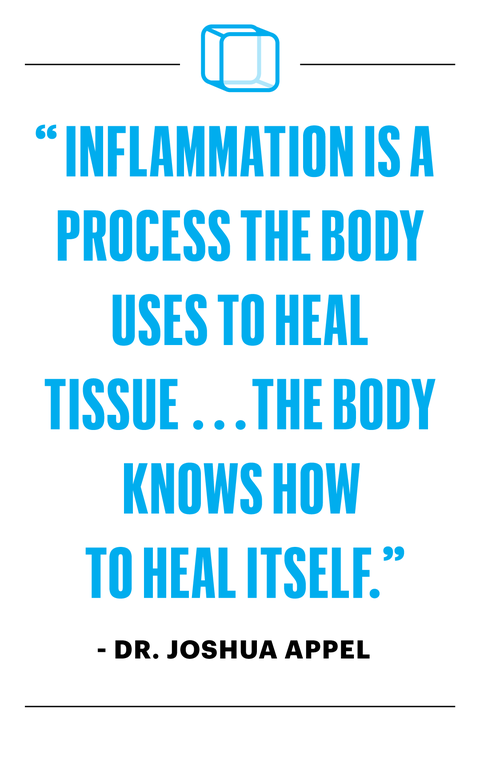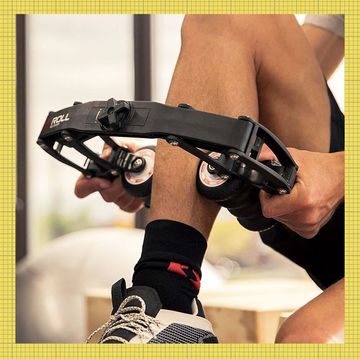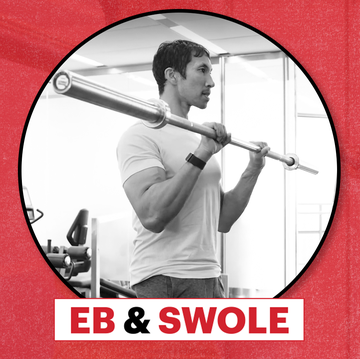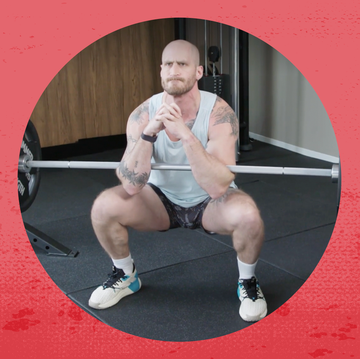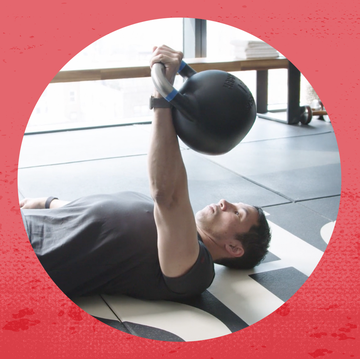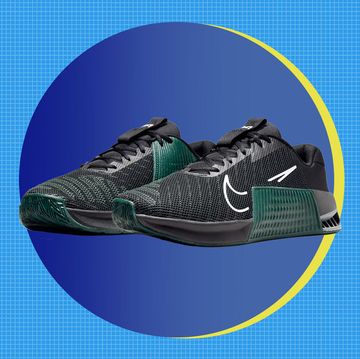THERE'S A GOOD CHANCE there's an ice pack in your freezer. And whenever you have back pain or knee soreness, you reach for it. You do this because you’ve been told that icing reduces swelling, speeds up the healing process, and helps you recover from hard workouts that batter your body.
You’ve seen the best athletes in the world doing it, too. There are dozens of photos of LeBron James with his knees wrapped in ice packs and his feet in a bucket of ice — and plenty of photos of Michael Jordan doing the same thing before that, too. Tiger Woods used to talk often about regular ice baths all throughout his comeback to the PGA Tour. Heck, Kansas City Chiefs quarterback Patrick Mahomes recently appeared in a DIRECTV commercial sitting in a tub of ice.
You think you’re doing it right, just like all those pros. But it’s been 50-plus years since Los Angeles Dodgers’ pitching legend Sandy Koufax first appeared in a 1965 Sports Illustrated photograph with his left arm submerged in a vat of ice, an iconic moment in sports. And since then, no piece of published, peer-reviewed research has shown definitively that ice is beneficial to the healing process. In fact, recent studies have shown the opposite. Ice can delay healing, increase swelling, and possibly cause additional damage to injured tissues.
That should stop you cold.
A Brief History of Where We Went Wrong
The procedure for injury management followed by most doctors, physical therapists and athletic trainers hasn’t changed since 1978, when Harvard physician Dr. Gabe Mirkin coined the term “the RICE protocol.” The acronym, which stands for “rest, ice, compression and elevation,” is still taught in medical and physical therapy schools today and is listed on the National Institute of Health website as the top treatment for both acute and chronic sports injuries. Dr. Rick Wright, an NIH grantee and a former physician with the St. Louis Blues, Cardinals, and Los Angeles Rams, still swears by it.
“Ice is the best modality to control pain, swelling and inflammation, especially if you ice for 25 to 30 minutes so you get actual cooling of the tissue and decrease inflammation, as opposed to shorter periods where you can get a rebound response,” says Wright, who is currently chair of the Department of Orthopedic Surgery at Vanderbilt University Medical Center. “There have not been well-done scientific studies that have crossed my desk that would make me say there was something I would use instead of ice that has been proven to work better. I have no plans to change any time in the near future.”
Yet even Mirkin now disagrees. These days, he tells anyone who will listen that he was wrong about both rest and ice. He wrote the forward to Gary Reinl’s 2013 self-published book, Iced! The Illusionary Treatment Option, which has become the bible of the growing anti-ice movement. “My RICE guidelines have been used for decades, but new research shows rest and ice actually delay healing and recovery,” says Mirkin, now 84.
Yes, says Mirkin, if your muscles are sore, you can relieve that pain with ice. But the inflammation causing that soreness is actually bringing healing to the body; by icing, you “dampen that immune response,” he says. “You think you’re recovering faster, but science has shown you’re not.”
Why, then, did Mirkin conceive RICE? Possibly, indirectly, from a freckled-faced 12-year-old named Everett Knowles, who in 1962 hopped a freight train in Somerville, Mass. on his walk home from school. As he did, Knowles’ right shoulder smashed into a stone bridge structure, severing his arm. The boy was rushed to Massachusetts General Hospital, where Harvard-educated surgeon Dr. Ronald Malt made a historic play: While deciding how to reattach Knowles’ arm – the first time such an operation would be successful – Malt put the appendage on ice.
Doctors began using the same protocol to treat all damaged tissue, especially in the sports world. When Mirkin wrote his book, he was simply reporting the anecdotal evidence of doctors who saw a temporary decrease in swelling and pain from immobilization, ice and compression. “In 1978, inflammation wasn’t even in researched literature, but everyone was resting, putting people in casts, wrapping things tightly with ice,” Mirkin says. “I didn’t recommend anything on the basis of extended research. I recommended what everyone was doing at the time.” And because “RIC” just wasn’t that catchy, and a gravitational assist can help blood and fluid be reabsorbed by the body, Mirkin added an “E” at the end for “elevation.” It made for a nice slogan: “RICE is Nice.”
The Case Against The Cold
Remember when your school nurse told you to ice the ankle you rolled at recess? Did she tell you to leave it on for five minutes? 10? 20? Was it cubes in a bag or chips a towel?
Your school nurse was right about exactly one thing: No study can dispute that ice is the cheapest, most readily available non-habit-forming way to alleviate pain. But be warned: the pain will return once the tissue rewarms and the inflammatory response resumes.
That’s because the inflammatory response needs to happen. The three stages of healing for soft tissue injuries are now universally accepted by the medical community: inflammation, repair and remodeling. And you can’t reach the repair and remodeling phases until you’ve gone through Phase One.
When tissue is damaged, the immune system initiates that inflammatory response, which a 2010 study published in the Federation of American Societies for Experimental Biology Journal showed is necessary to heal damaged tissue and repair muscle. The body deploys its repair and cleanup crew in the form of macrophages, white blood cells that engulf and digest cellular debris. They produce the protein insulin-like growth factor 1, which is required for muscle repair and regeneration. The same study showed that blocking inflammation delays healing by preventing the release of IGF-1.
Ice delays this process by constricting blood vessels and allowing less fluid to reach the injured area, as demonstrated in a 2013 study in the Journal of Strength and Conditioning Research. This research showed that topical cooling delays recovery from eccentric exercise-induced muscle damage. Additionally, a 2015 article published in Knee Surgery, Sports Traumatology, Arthroscopy showed that the narrowing of blood vessels caused by icing persists after cooling ends and the resulting restriction of blood flow can kill otherwise healthy tissue; that is, icing causes more damage on top of the existing injury.
And as far back as 1986, a study published in the journal Sports Medicine showed that when ice is applied for a prolonged period, lymphatic vessels become more permeable, causing a backflow of fluid into the interstitial space. That means local swelling at an injury site will increase, not decrease, with the use of ice.
This isn’t just about serious injuries, either; it’s about the way you recover from workouts. Remember: having very sore quads because of a workout is different from a torn quadriceps only by degrees. A 2014 study published in the Journal of Strength & Conditioning Research and another done by the University of Queensland showed cold water immersion after training — ice baths — substantially reduces long-term gains in muscle mass and strength by stunting the cell activity crucial for building stronger muscles. When you hit the cold tub after hard exercise, thinking you are reducing inflammation, you’re actually delaying recovery.
Inflammation and swelling have been deemed the enemy, but only swelling is actually bad. “Inflammation is a process the body uses to heal tissue, while swelling is a byproduct of that process,” says Dr. Joshua Appel, an Air Force flight surgeon for the 306th Pararescue Squadron and chief of emergency medicine at Southern Arizona VA Healthcare System. “When you recruit inflammatory markers to an acutely injured area, with that comes fluid. The body knows how to heal itself, so you’re not getting too much fluid. But you can have not enough evacuation.”
Losing the Cool: Alternatives To Ice
How, then, does the body clear swelling? Most of the particles are too large to move through the vessels of the circulatory system, so they must instead be evacuated through the vessels of the lymphatic system. The lymphatics, though, are a passive system, fully reliant on muscle activation; movement is necessary to propel fluid through the vessels. Sitting still with an ice pack creates the exact opposite effect. “With an acute injury, you want to get the good stuff in and the bad stuff out,” says Appel, who no longer uses ice to treat the countless ankle and knee injuries suffered by his para-rescue jumpers. “The only way to do that is through movement.”
Think about it. Do you think our hunter-gatherer ancestors rolled their ankles, dug some ice out of a snowbank, sat down and stopped chasing dinner? It's more likely that they forged on, and the movement facilitated healing. Pushing a sprained ankle may sound ill-advised, but a 1999 study published in the Journal of the American Academy of Orthopedic Surgeons showed that loading damaged tissue — that is, applying force to it — accelerates healing of bone and muscle tissue, while inactivity promotes aberrant tissue repair.
Moving sore muscles is easy. Corey Kluber, two-time Cy Young-winning ace of the Cleveland Indians staff, hasn’t iced his arm since making the big leagues in 2011. Instead, Kluber does light-resistance exercises that target his rotator cuff muscles after he pitches, naturally activating muscles and moving fluid out of tissues damaged during his starts. “When I was younger, I iced because that's what people did, that's what I was told to do,” Kluber says. “But over time, I realized I felt better not icing.” The result: Kluber says he can warm up more quickly the day after pitching.
Acute injuries, of course, are more complicated. No, you don’t want to squat 350 pounds on a torn ACL. But let’s say you sprain your ankle. If your physical therapist clears you to stand on it, don’t hesitate to do it.
If an injury is too painful or the area is too fragile for any type of voluntary movement, consider using a neuromuscular electrical stimulation device (better known as electrostim), says physical therapist and legendary mobility guru Kelly Starrett. Such devices (and there are more and more of them on the market) create non-fatiguing muscle contractions, allowing waste and congestion to be removed by your lymphatic system, which is driven by muscle contraction.
Starrett says seven years ago, he had a patient who had just had reconstructive ACL surgery. He rehabbed the injury with no ice at all, instead using an electrostim device. “We had no swelling 24 hours post-surgery,” Starrett recalls. Electrostim therapy generally involves connecting the body diodes that send light electrical charges to muscles, stimulating them to activity. Starrett says his patient’s range of motion and quadriceps control, which often take weeks to regain after ACL reconstruction, were restored almost immediately.
And because there was no swelling, there was no pain. “We have to allow the body to excel at what it does automatically, which is heal,” Starrett says. “If you’re icing, you’re getting in the way, not facilitating.”
In 2011, Canadian exercise physiologist John Paul Catanzaro coined the term METH — Movement, Elevation, Traction, Heat — as an alternative to RICE. In April 2019, two British physical therapists proposed another acronym in the British Journal of Sports Medicine: PEACE — Protect, Elevate, Avoid anti-inflammatory modalities, Compress, Educate — & LOVE — Load, Optimism, Vascularization, Exercise. All these ideas want you prioritizing movement over decreasing inflammation.
So why do doctors and therapists still use ice? Because they always have, speculates Chip Schaefer, the Chicago Bulls’ director of performance health who won six NBA titles with Michael Jordan’s Bulls. In the mid-90s, Schaefer says, it was considered progressive to put ice on every player’s knees after practices and games. But not anymore. “You're always going to fall back to, ‘well, I did this with Jordan and he got better’,” says Schaefer, “rather than looking objectively at research. But we try to pride ourselves on following evidence-based practice.”
Athletes are no different. Many, like you, have been icing for as long as they can remember — and is a trainer really going to say no to LeBron’s request for ice?
But healing is the name of the game, and faster recoveries happen without ice. More and more people are realizing that — and you should too.
Because the meltdown has already begun.




